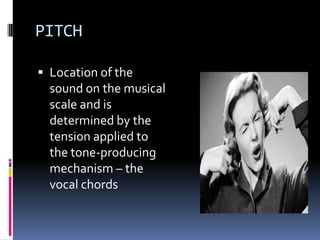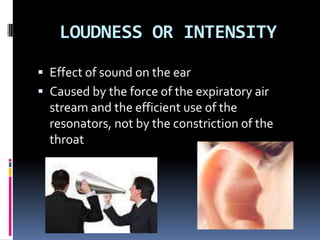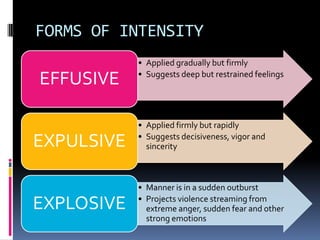Voice
- 1. The Voice
- 2. VOICE The production of sound
- 3. speech Combination of sounds
- 4. Quality The distinctive characteristic of the voice that makes it pleasant or unpleasant to hear Often referred as timbre or tone color Results from the weight exerted on the vocal chords by the resonators in the process of speaking
- 5. CHARACTERISTICS OF A GOOD VOICE Clear Pleasant Varied Understandable Free from tension
- 6. ELEMENTS OF THE VOICE WHICH REFLECT MOOD: Quality Pitch Force or intensity rate
- 7. PITCH Location of the sound on the musical scale and is determined by the tension applied to the tone-producing mechanism – the vocal chords
- 8. IMPORTANT ASPECTS OF PITCH Key or general level of the voice– general pitch level Inflections– change in pitch occurring between syllables or words Melody patterns– rhythm and swing of your phrases and sentences
- 9. COMMON VOICE QUALITIES NORMAL BREATHY FULL CHESTY THIN • Speaking • Creating an • Also • Deep • High- naturally atmospher known as hollow pitched e of secrecy the voice as if showing • Showing and orotund or coming old-age, little or no mystery round from a extreme emotion mouth deep and fatigue or quality empty weakening • Formal and cave or even dignified extreme excitement
- 10. LOUDNESS OR INTENSITY Effect of sound on the ear Caused by the force of the expiratory air stream and the efficient use of the resonators, not by the constriction of the throat
- 11. DEGREE The amount of force applied so that in whispering only a low degree of force is used whereas in shouting, a high degree of force is applied
- 12. FORMS OF INTENSITY • Applied gradually but firmly EFFUSIVE • Suggests deep but restrained feelings • Applied firmly but rapidly EXPULSIVE • Suggests decisiveness, vigor and sincerity • Manner is in a sudden outburst EXPLOSIVE • Projects violence streaming from extreme anger, sudden fear and other strong emotions
- 13. VOLUME Degree of loudness
- 14. PROJECTION Process of directing the voice to a specific target
- 15. TARGET Particular direction to which you are aiming and addressing
- 16. Thank you!
















